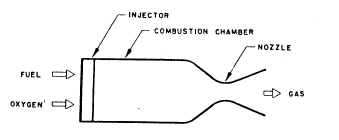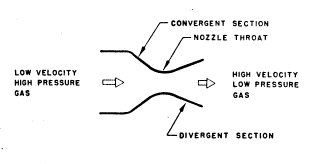HOW to DESIGN, BUILD and TEST SMALL LIQUID-FUEL ROCKET ENGINES
ROCKETLAB / CHINA LAKE, CALIF.
NOTICE
ROCKETLAB cannot assume responsibility, in any manner whatsoever, for
the use readers make of the information presented herein or the
devices resulting therefrom.
FOREWORD
The rocket engine is a relatively simple device in which propellants
are burned and the resulting high pressure gases are expanded through
a specially shaped nozzle to produce thrust. Gas pressurized
propellant tanks and simple propellant flow controls make operation
of a small liquid-fuel rocket engine about as simple as operating an
automobile engine. Why then do so many amateur rocket engines fail or
cause injury? The reason, usually and simply, is that the amateur is
not accustomed to high pressure devices operating near material
temperature limits. His normal everyday life is, instead, filled with
devices and gadgets operating at low pressures and at low thermal
energy levels. With proper design, careful workmanship, and good test
equipment, operated in a safe manner, the amateur can build small,
liquid-fuel rocket engines which will have hours of safe operating
life.
The puropse of this publication is to provide the serious amateur
builder with design information, fabrication procedures, test
equipement requirements, and safe oeprating procedures for small
liquid-fuel rocket engines.
INTRODUCTION
A liquid rocket engine employs liquid propellants which are
fed under pressure from tanks in to a combustion chamber. The
propellants usually consist of a liquid oxidizer and a liquid fuel. In
the combustion chamber the propellants chemically react (burn) to
form hot gases which are then accelerated and ejected at high velocity
through a nozzle, thereby imparting momentum to the engine. Momentum
is the product of mass and velocity. The thrust force of a rocket
motor is the reaction experienced by the motor structure due to the
ejection of the high velocity matter. This is the same phenomenon
which pushes a garden hose backward as water squirts from the nozzle
or makes a gun recoil when fired.

Figure 1 Typical Rocket Motor
A typical rocket motor consists of the combustion chamber, the
nozzle, and the injector, as shown in Figure 1. The combustion chamber
is where the burning of propellants takes place at high pressure. The
chamber must be strong enough to contain the high pressure generated
by, and the high temperature resulting from, the combustion process.
Because of the high temperature and heat transfer, the chamber and
nozzle are usually cooled. The chamber must also be of sufficient
length to ensure complete combustion before the gases enter the
nozzle.

Figure 2 DeLaval Nozzle
The function of the nozzle is to convert the chemical-thermal
energy generated in the combustion chamber into kinetic energy, The
nozzle converts the slow moving, high pressure, high temperature gas
in the combustion chamber into high velocity gas of lower pressure and
temperature. Since thrust is the product of mass (the amount of gas
flowing through the nozzle) and velocity, a very high gas velocity is
desirable. Gas velocities from one to two miles per second (5000 to
12000 feet per second) can be obtained in rocket nozzles. Nozzles
which perform this seemingly amazing feat are called DeLaval nozzles
(after their inventor) and consist of a convergent and divergent
section, as shown in Figure 2. The minimum flow area between the
convergent and divergent section is called the nozzle throat. The flow
area at the end of the divergent section is called the nozzle exit
area. The nozzle is usually made long enough (or the exit area is
great enough) such that the pressure in the combustion chamber is
reduced at the nozzle exit to the pressure existing outside the
nozzle. If the rocket engine is being fired at sea level this pressure
is about 14.7 pounds per square inch (psi). If the engine is designed
for operation at high altitude, the exit pressure is less than 14.7
psi. The drop in temperature of the combustion gases flowing through
the nozzle is high and can be as much as 2000-3000 F. Since the gases
in the combustion chamber nay be at 5000-6000 F, the gas temperature
at the nozzle exit is still about 3000 F.
